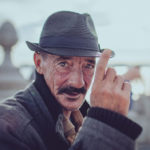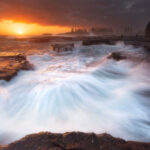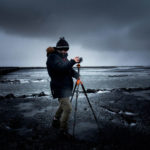Twenty-five years ago, Photoshop started out as just a little tool in a photographer’s tool kit. Today, it has become one of the most powerful tools for any photographer. In honor of Photoshop’s 25th anniversary, commercial photographer and darkroom expert Konrad Eek works up a couple film prints using photography altering techniques that are now represented by Photoshop tools:
Dodging and Burning Techniques
Eek starts with a base exposure and uses his dodge tool (a piece of wire with a black tape cut out in the shape of the area he wants to dodge) to selectively reduce the amount of light that hits the paper, thereby reducing the density of that area on the print. Starting with a 10 second base exposure, he dodges for about two seconds in one area of the print. (Via PetaPixel)

Next, he wants to increase exposure. Eek uses his hand (the traditional burning tool) to add light to a couple areas of the print. He starts by blocking the light from the enlarger as he turns it on, then moves his hand to selectively add light to the print.
Lastly, he does a gradated burn, which is the same as doing a levels adjustment with a gradation in your mask. He uses his gradient tool (a card that is white on one side and black on the other), moving the card down and back to create a gradient across the top of the paper.
The exposure is now done, so he puts the print into the developer, which turns the exposed silver halite crystals into black metallic silver.
“There’s not a comparable tool in Photoshop for this and that’s why I still like the magic of the darkroom.”
Creating a Burning Mask
The second print Eek works on has to be adjusted because the sky is too bright in relation to the foreground.
Photoshop has amazing contrast control tools, making this an easy fix digitally, but in the darkroom, things weren’t so simple. Here’s how to create a burning mask in the darkroom:
Eek places a roll of tape in the middle of the image to use as a spacer, then puts a piece of white card stock on it; the card is now capturing the image from the enlarger. Like a selection tool, he traces along the edge of the treeline, then cuts it out. The new cutout is his burning mask.
Remembering the height where he started, Eek takes the burning mask and, starting the exposure time, quickly brings the card down to the print, gently jiggling it (which is equivalent to feathering the edge of a selection), then brings it back up and out to mask the foreground.
The aim here is to burn in the sky for almost twice the exposure the foreground area has to get them to balance out well. If you just hold the card stock in place, you’ll probably end up with a halo that is either too dark on the foreground or too light in the sky, so by feathering, you’ll even it out.

Comparison of one edited print against the original
Back in the days of the darkroom, the photographer had to be extremely meticulous and organized. As Eek points out, he would keep the negatives, masks, or other tools he had created, and notes in a folder to refer to later if he wanted to repeat the effect. Photoshop allows us to save our data so it’s always there, ready and waiting. It really makes things a lot easier!
Like This Article?
Don't Miss The Next One!
Join over 100,000 photographers of all experience levels who receive our free photography tips and articles to stay current:








I’ll admit, I do must of my photo editing in Lightroom and Photoshop these days, but every once in a while, I still seal off the spare bathroom and set up my enlarger. Nothing really compares to using a real darkroom.
I remember spending 8+ hours a day in the school darkroom and an hour a week in Photoshop 4.0! Times have changed.
I spent many years in the darkroom. It was magical then. Now I appreciate what technology offers. Government website design thrives in the digital age.